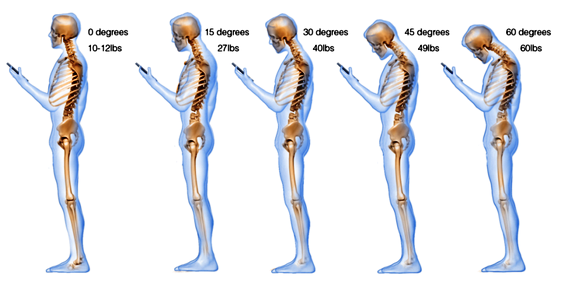There are a lot of things that can cause a pain in the neck not related to your boss, your mother-in-law or even your pending income taxes.
Sleeping in an odd or uncomfortable position, bending over a desk for hours, and exercise injuries are all common causes. But there’s a fairly new way we are giving ourselves neck pain, and chances are you are doing it now.
According to an article published late last year in the journal Surgical Technology International, looking down at your tablet or cell phone is the equivalent of placing up to 60 pounds of weight on your neck.
That’s four large bowling balls. Or three really large Thanksgiving turkeys. Or, well, a 60-pound barbell.
New York back surgeon Ken Hansraj used a computer model of the human spine to come up with the eye-opening number. The average human head weighs up to 12 pounds. Tilting it downward to check Facebook or Twitter, to watch a show on Netflix or Hulu, or to read a medical blog increases the gravitational pull on the cranium.
“As the head tilts forward the forces seen by the neck surges to 27 pounds at 15 degrees, 40 pounds at 30 degrees, 49 pounds at 45 degrees and 60 pounds at 60 degrees,” Hansraj writes in the paper. “These stresses may lead to early wear, tear, degeneration and possibly surgeries.”
Now think for a moment about how many times a day you check your smart phone. Take a look the next time you are in line at the bank or supermarket and see how many people are doing that very thing. Notice their posture – are they standing straight and looking forward at the phone with little or no bend in their neck?
Probably not.
There’s even a name for this condition; it’s called “text neck.” The name is a little misleading since online gaming, social media, and just web surfing on our phones are equally to blame for this form of neck pain.
The amount of time we spend on tablets and smart phones is only increasing as smart phones, tablets and data plans become cheaper, and the technology becomes easier to use. That means disc herniations and pinched nerves, and even a flattening or reversing of the natural curve of your neck, will become more common problems in the future.
But it doesn’t have to be this way. Here are some simple tips to avoid “text neck.”
- Be aware of how you are holding your head in space when you are looking at your phone or tablet. Make sure you are holding close to eye level.
- Take frequent breaks every 15 or 20 minutes that you are on your iPhone or Android device.
- During these breaks, stand up and stretch.
- Roll your shoulders clockwise, then counterclockwise.
- Do side-to-side neck stretches, then rotate your neck looking left, then right
- Take advantage of “hands-free” functions such as Siri, Cortana or Google voice.
- Try increasing the font size on your screen, or magnifying what you are reading
- Think about investing in a stand for your tablet or phone so you can set it on a desk or counter without having to look down at a dramatic angle.
If you are like me, then using a tablet or smart phone is just a part of everyday life. The key is to make it as safe and healthy a habit as possible.
Safe texting everyone.
Dr. Annette “Dr. Z” Zaharoff heads the Non-Surgical Center of Texas, focusing on non-surgical alternatives to relieve pain and repair injuries. A former professional tennis player who competed in the WTC circuit, Dr. Zaharoff remains actively involved with the US Tennis Association. Learn more about her at www.drzmd.com.

